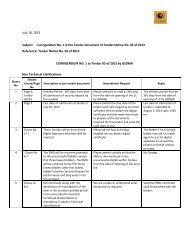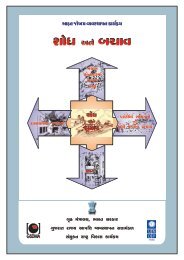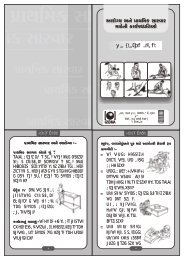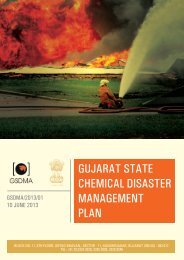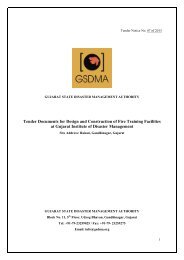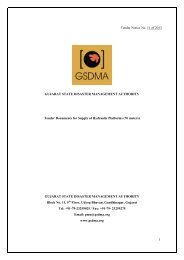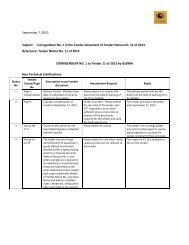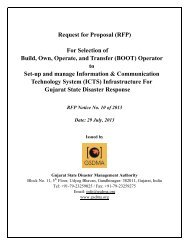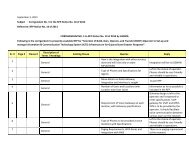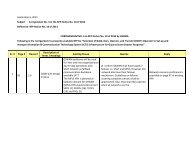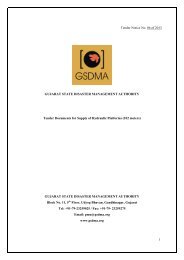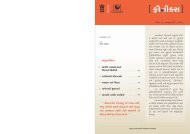Emergency Response Guidebook - Gujarat State Disaster ...
Emergency Response Guidebook - Gujarat State Disaster ...
Emergency Response Guidebook - Gujarat State Disaster ...
You also want an ePaper? Increase the reach of your titles
YUMPU automatically turns print PDFs into web optimized ePapers that Google loves.
GUIDE111Mixed Load/Unidentified CargoERG2012ERG2012Mixed Load/Unidentified CargoGUIDE111POTENTIAL HAZARDSFIRE OR EXPLOSION• May explode from heat, shock, friction or contamination.• May react violently or explosively on contact with air, water or foam.• May be ignited by heat, sparks or flames.• Vapours may travel to source of ignition and flash back.• Containers may explode when heated.• Ruptured cylinders may rocket.HEALTH• Inhalation, ingestion or contact with substance may cause severe injury, infection, disease or death.• High concentration of gas may cause asphyxiation without warning.• Contact may cause burns to skin and eyes.• Fire or contact with water may produce irritating, toxic and/or corrosive gases.• Runoff from fire control may cause pollution.PUBLIC SAFETY• CALL EMERGENCY RESPONSE Telephone Number on Shipping Paper first. If Shipping Paper notavailable or no answer, refer to appropriate telephone number listed on the inside back cover.• As an immediate precautionary measure, isolate spill or leak area for at least 100 meters (330 feet) inall directions.• Keep unauthorized personnel away.• Stay upwind.• Keep out of low areas.PROTECTIVE CLOTHING• Wear positive pressure self-contained breathing apparatus (SCBA).• Structural firefighters' protective clothing provides limited protection in fire situations ONLY; it maynot be effective in spill situations.EVACUATIONFire• If tank, rail car or tank truck is involved in a fire, ISOLATE for 800 meters (1/2 mile) in all directions;also, consider initial evacuation for 800 meters (1/2 mile) in all directions.EMERGENCY RESPONSEFIRECAUTION: Material may react with extinguishing agent.Small Fire• Dry chemical, CO 2, water spray or regular foam.Large Fire• Water spray, fog or regular foam.• Move containers from fire area if you can do it without risk.Fire involving Tanks• Cool containers with flooding quantities of water until well after fire is out.• Do not get water inside containers.• Withdraw immediately in case of rising sound from venting safety devices or discoloration of tank.• ALWAYS stay away from tanks engulfed in fire.SPILL OR LEAK• Do not touch or walk through spilled material.• ELIMINATE all ignition sources (no smoking, flares, sparks or flames in immediate area).• All equipment used when handling the product must be grounded.• Keep combustibles (wood, paper, oil, etc.) away from spilled material.• Use water spray to reduce Vapours or divert Vapour cloud drift. Avoid allowing water runoff tocontact spilled material.• Prevent entry into waterways, sewers, basements or confined areas.Small Spill• Take up with sand or other non-combustible absorbent material and place into containers for laterdisposal.Large Spill• Dike far ahead of liquid spill for later disposal.FIRST AID• Move victim to fresh air.• Call 108 or emergency medical service.• Give artificial respiration if victim is not breathing.• Do not use mouth-to-mouth method if victim ingested or inhaled the substance; give artificialrespiration with the aid of a pocket mask equipped with a one-way valve or other properrespiratory medical device.• Administer oxygen if breathing is difficult.• Remove and isolate contaminated clothing and shoes.• In case of contact with substance, immediately flush skin or eyes with running water for at least 20minutes.• Shower and wash with soap and water.• Keep victim warm and quiet.• Effects of exposure (inhalation, ingestion or skin contact) to substance may be delayed.• Ensure that medical personnel are aware of the material(s) involved and take precautions to protectthemselves.Page 162Page 163



